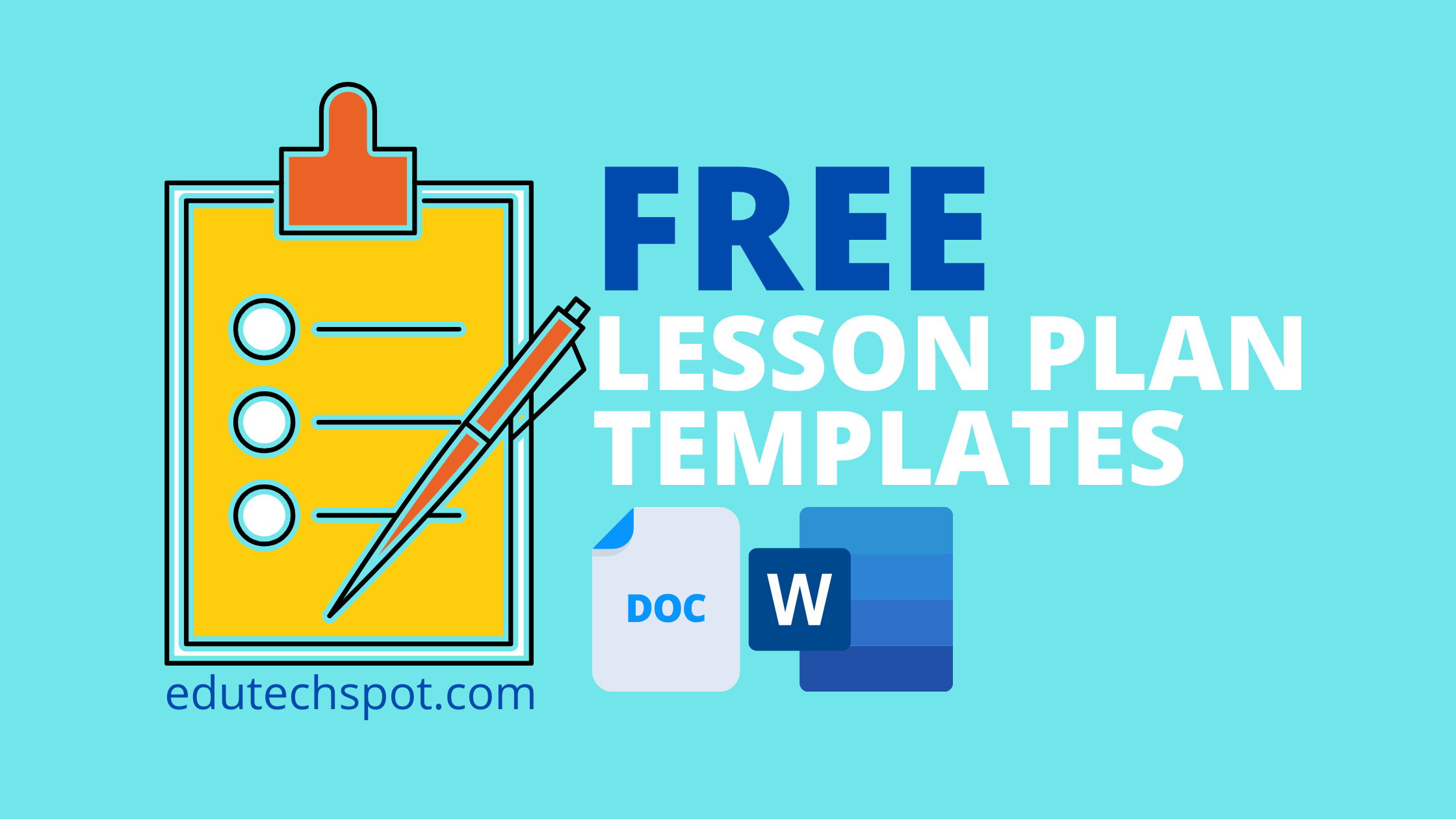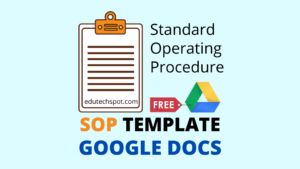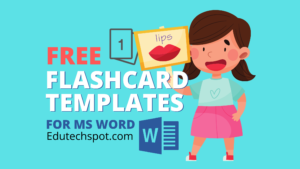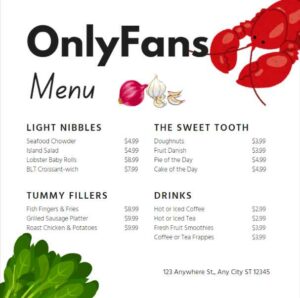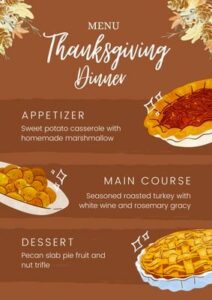Lesson plan template google docs. All teachers or educators need lesson plan in order to provide better and well prepared teaching and learning, but to create and layout a lesson plan from scratch may not be that easy.
Here are some selected professional lesson plan templates and samples used by real educators from highly respected universities, colleges, and schools.
Use, edit, and adjust them to jump start your lesson plan creation.
Briefly study and learn some fundamental aspects in composing good lesson plans.
Before copying the template file, please make sure that you have logged in to your Google account. To learn more, please read: How to make a copy of a file in Google Drive
Lesson Plan Template Google Docs

Hi Teachers and Educators! These templates are available in Microsoft Word and Google Docs formats, and they come from various levels: Preschool / Kindergarten / elementary school / high school. Thus, some of them offer simple layout and lesson plan items. These templates are used by prominent schools, universities, and colleges. Thus, the outline parts of the lesson are factually required by the schools. They have been explored and studied by the teachers, and thus, the senior teachers encourage new teachers to use the existing selected templates that they have used so far and that they have proven the efficacy of the lesson plans. Here they are:
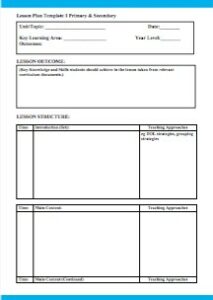
Parts: Lesson outcome, teaching approaches, resources, required equipment, safety consideration, materials, assessment, reflection.
Source: Charles Darwin University, Australia. https://www.cdu.edu.au
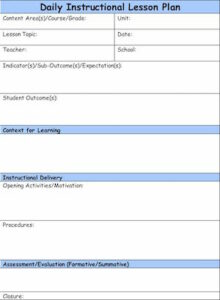
Parts: Daily instructional, Lesson Topic, Teacher, Indicators, sub-outcome, expectation, student outcome, context for learning, opening activities, motivation, procedures, Assessment or Evaluation (formative / summative), closure..
Source: Montgomery Country Public Schools. https://www.montgomeryschoolsmd.org
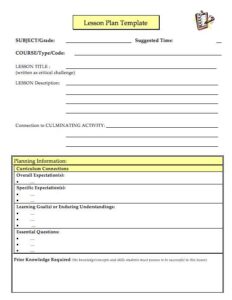
Parts: Lesson description, connection to culminating activity, Curriculum connections (overall expectation, specific expectation, learning goals or enduring understandings, essential questions), prior knowledge requirement, evaluation checklist, list of resources, teacher reflection.
Source: University of Toronto. https://www.oise.utoronto.ca
These are parts of the Simple Layout.
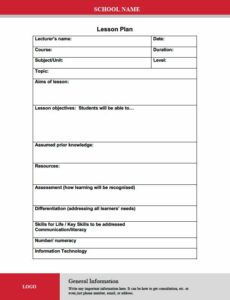
Parts: Topic, aims of lesson, lesson objectives (students will be able to … ), assumed prior knowledge, resources, assessment (how learning will be recognised), differentiation (addressing all learners’ need), Skills for Life / Key Skills to be addressed (communication / literacy), Information Technology. Flow: Content & Teacher Activity, Student Activity, Homework / Assignments set.
Source: Harrow College UK. https://www.harrow.ac.uk/
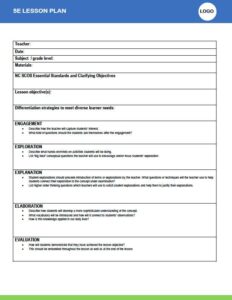
Parts: Essential Standards and Clarifying Objectives, Lesson Objectives, Differentiation strategies to meet diverse learner needs, 5E Lesson plan (Engagement, Exploration, Explanation, Elaboration, Evaluation).
Source: https://www.cs.duke.edu/
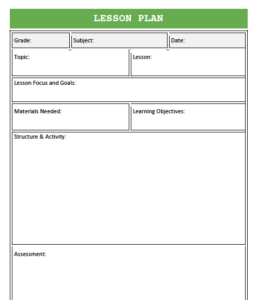
Parts: Lesson focus and goals, materials needed, learning objectives, assessment.
Source: https://edutechspot.com

Parts: length of lesson, planning for desired results, objectives (content and language), essential questions, prior knowledge, evidence, learning plan, introduction, body of the lesson, guiding questions, closing, teacher reflection.
Source: https://www.lowell.k12.ma.us/
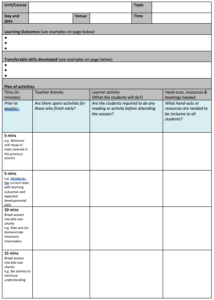
Parts: learning outcomes, transferable skills developed, teacher activity, learner activity, handouts, resources, books needed, learning topic introduction, break session, student feedback, preparation for next lesson
Source: https://www.solent.ac.uk/
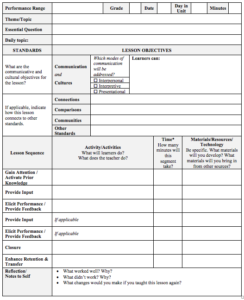
Parts: performance range, essential question, daily topic, grade, communication and cultures, connections, comparisons, communities, lesson sequence, gain attention, activate prior knowledge, provide input, elicit performance, provide feedback, materials, resources, technology, closure, enhance retention & transfer, reflection (teacher self notes).
Source: https://www.actfl.org/
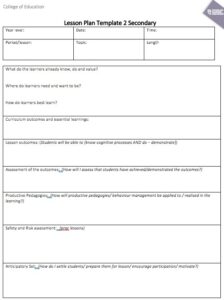
Parts: College Level. Curriculum outcomes and essential learnings, lesson outcomes, assessments, productive pedagogies, safety and risk, anticipatory set (how to settle students, prepare for the lesson, encourage participation and motivation). Flow: Introductory set, body of lesson, consolidation, summing up and link to the next lesson, homework, evaluation.
Source: https://www.cdu.edu.au
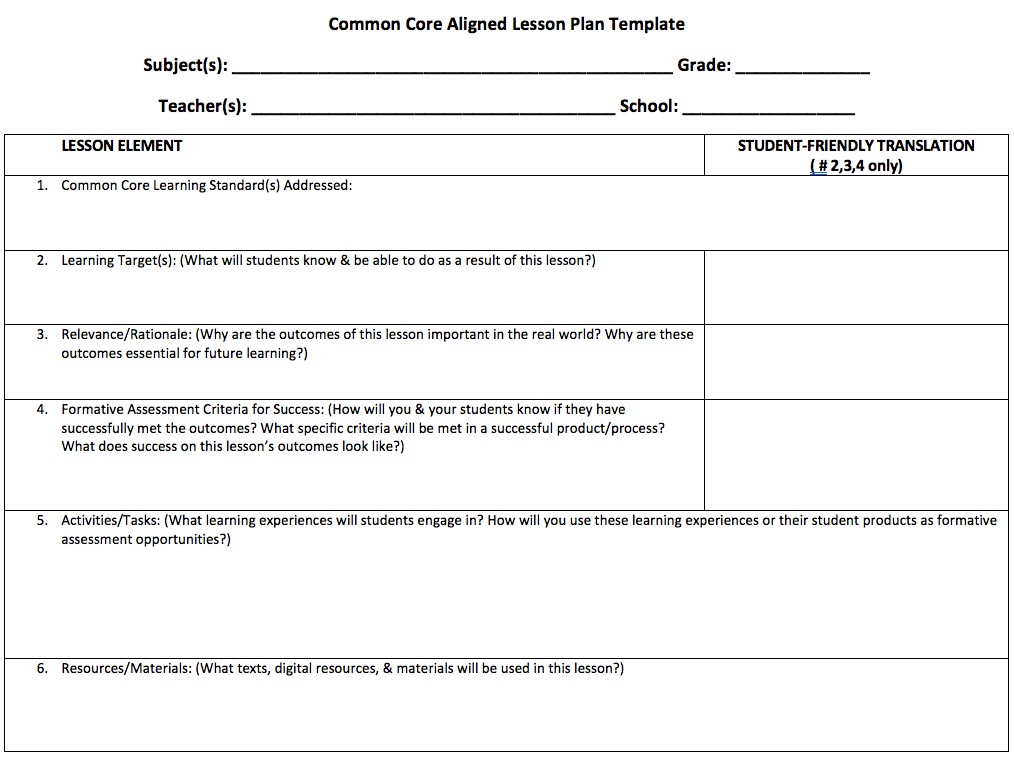
Parts: common core learning standards, learning targets, relevance / rationale, formative assessment criteria for success, activities/tasks, resources/materials, modifications and accommodations. Questions (whether: support 21st century skills, reflect academic rigor, cognitively engage students, encourage collaborative learning).
Source: https://www.scoe.org
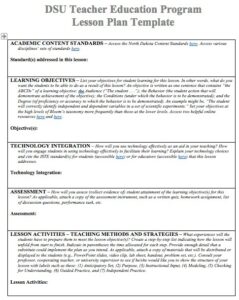
Parts: academic content standards, learning objectives, technology integration, assessment, teaching methods and strategies, research base for teaching strategy, lesson modifications, materials, technology, media.
Source: https://www.dickinsonstate.edu/

By using these Free templates, you will learn and see more lesson plan formats. You can compare some of them and you will notice different lesson plan layouts. Every format also comes with different outlines. Sometimes you may find the parts naming difficult and confusing. Different models of lesson plan templates sometimes use different phrases. However, they always come with the guide that explains what you need to write in that section. For example, you find it difficult to start writing into the objectives column, or maybe the reflection column, but you will see some examples to start the sentence with. Eventually, as the time goes on, as you practice more, you will find it easy, and making lesson plans is easy. You can even decorate it with some artworks. You can make online art using specific free tools.
weekly lesson plan template google docs
In case you need a weekly lesson plan template, here are some simple layouts that I have crafted. This weekly template is simpler, at least to some teachers. The term weekly actually contains days within a week, so you would see rows showing the week days: from Monday to Friday. More about Weekly
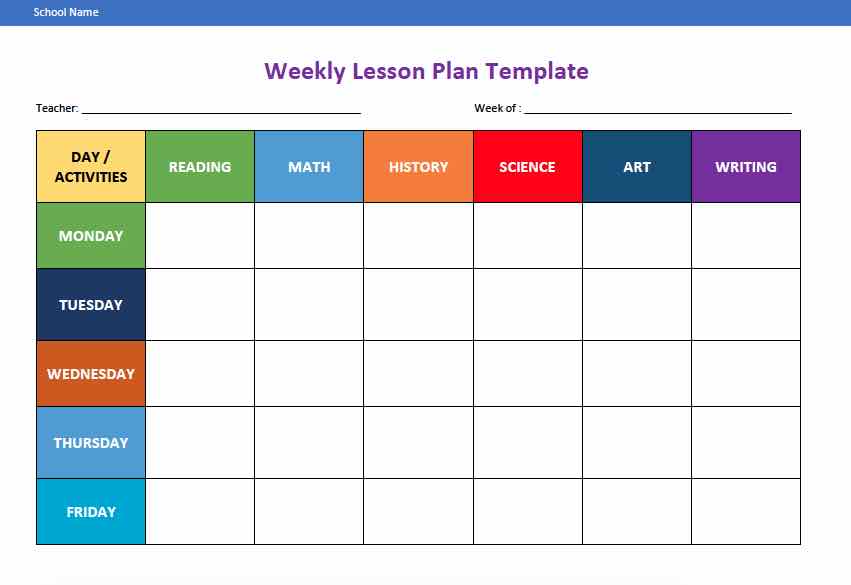
Parts: Days, Activities, colorful
Source: https://edutechspot.com
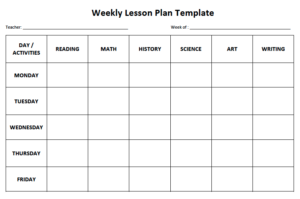
Parts: Days, Activities
Source: https://edutechspot.com
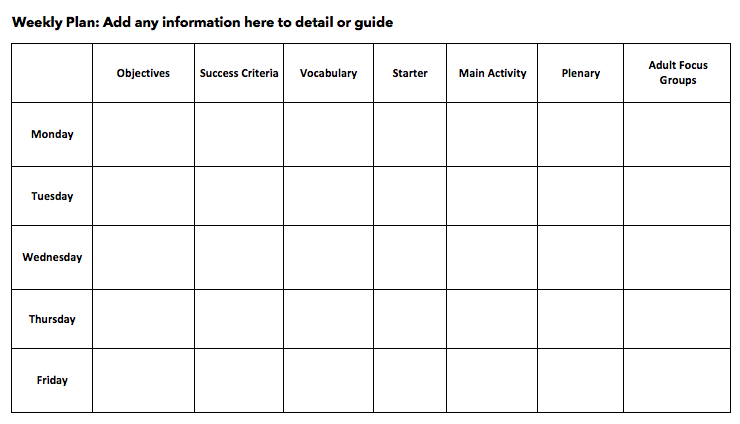
Parts: Monday to Friday
Source:https://edutechspot.com

Parts: Weekly lesson planning –> Days, Activities, clean
Source: https://edutechspot.com
In my opinion, power points or google slides are very handy for making layouts, just any layout including lesson plan. I feel like they are similar to vector graphic design software like CorelDraw or Adobe Illustrator. I even created newspaper templates in google slides and powerpoint. In my opinion, they are easier to use than microsoft word or google docs. Even more, I have made flashcard templates using power point. Anyway, these are the lesson plan templates, google slides and powerpoint version.

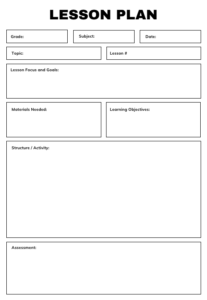
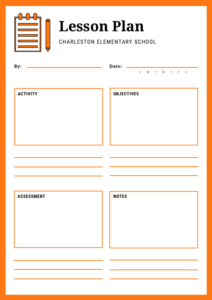
Physical Education Lesson Plan Templates
Edutechspot.com provides a range of lesson plan templates for physical education, which are designed to help teachers plan and organize their lessons effectively. A physical education lesson plan template typically includes sections for equipment, warm-up activities, instruction, assessment, and reflection, and can be customized for different levels of education. they include resources for teachers, such as lesson plan samples and templates from respected schools, universities, and colleges. We Edutechspot.com have a dedicated page showcasing these templates, which can be accessed for further information and use. See Physical Education Lesson Plan Template
Virtual Lesson
We have provided a virtual one that you can use for supporting your remote, online, or distance learning activity. Hopefully the template will be helpful.
Common Questions for Reflection
- Did I achieve the overall objectives of the lesson? How do I know?
- What parts of the lesson were effective?
- What parts of the lesson did not succeed as well, and why?
- How would I evaluate my introduction to the lesson?
- To what extent were students productively engaged during the lesson?
- What changes did I make in the lesson as I taught it? Specify where and why.
- Were there any unanticipated occurrences?
- Did any classroom management issues arise? How did I respond?
- Did I achieve appropriate closure for the lesson?
- If I were to teach this lesson again, what changes would I make?
Frameworks for Perfect Lesson Planning
Writing a lesson plan, for most first timers, is difficult because there are so many aspects to cover. Based on my experience in building a lesson plan, I found it very hard.
Then, I decided to just observe some existing examples of lesson plan. I collected a lot of template in lesson planning. Some were similar, and some others were so much different. Some were simple, and some others were so complicated and detailed. No matter what kind of lesson plan you make, some of the following items are mostly used as frameworks in building a great lesson plan:
- Aims
- Objectives
- Assessment data on pupils
- Scope and content
- Pedagogical methods
- Teacher’s expectations
- Learning activities
- Homework
- Differentiation of learning
- Progression in learning
- Other curricular links
- Time
- Space
- Resources
- Language
- Ancillary staff
- Risks
- Assessment
- Evaluation method(s)
- Review procedure(s)
FAQ
Lesson planning is essential because it allows teachers to ensure that the activities that take place in their classrooms on a daily basis provide students with a suitable level of long-term development through the objectives stated in the lesson’s context and pattern, along with their distinctive education plans when required.
Guided practice is a teaching style in which the teacher gradually releases responsibility to the student as they acquire and master new abilities or concepts. It is an important part of lesson design and is frequently combined with other instructional tactics to ensure that students are well-supported and able to learn well. Here’s an overview of the steps in guided practice:
I Do: The teacher demonstrates the task or skill, breaking it down into simple, understandable stages. Students observe, make notes, and ask questions.
We Do: The instructor and students collaborate to finish a task or skill. This collaborative phase allows students to practice the new ability while being guided and supported by the teacher.
You Do: Students attempt to execute the work or skill on their own, with the teacher giving prompts, open-ended questions, and visual aids as required to support learning.
You Do (independent practice): Students accomplish the activity or skill independently, without direct teacher assistance, to demonstrate mastery of the skill.
Guided practice is especially beneficial for individuals who require further assistance or for complicated tasks that necessitate a high degree of comprehension. It enables teachers to adjust their training to the specific requirements of individual students, offering scaffolding and feedback as needed to ensure that students can learn and apply the skills successfully.
Stay Current with the Latest in Google Docs Lesson Planning
As technology evolves, so does the landscape of lesson planning in Google Docs. Stay ahead of the curve with these updates and trends:
1. Collaborative Features: Leverage Google Docs’ collaborative tools to foster teamwork among educators. Explore features like real-time editing, comments, and suggestions for seamless collaboration on lesson plans.
2. Integration with Google Classroom: Discover how Google Docs seamlessly integrates with Google Classroom, streamlining assignment distribution and student engagement. Explore ways to enhance your teaching workflow by incorporating these tools.
3. Mobile Accessibility: With the increasing use of mobile devices, ensure your lesson plans are accessible on various platforms. Google Docs offers mobile-friendly options, allowing educators to plan and access lessons on the go.
4. New Templates and Add-ons: Keep an eye on the latest Google Docs templates and add-ons specifically designed for educators. These resources can add a creative and efficient touch to your lesson planning process.
5. Tips for Time Management: Explore time-saving tips within Google Docs to optimize your lesson planning efficiency. From keyboard shortcuts to template organization, discover hacks that make your workflow smoother.
Recommended Books on Lesson Planning
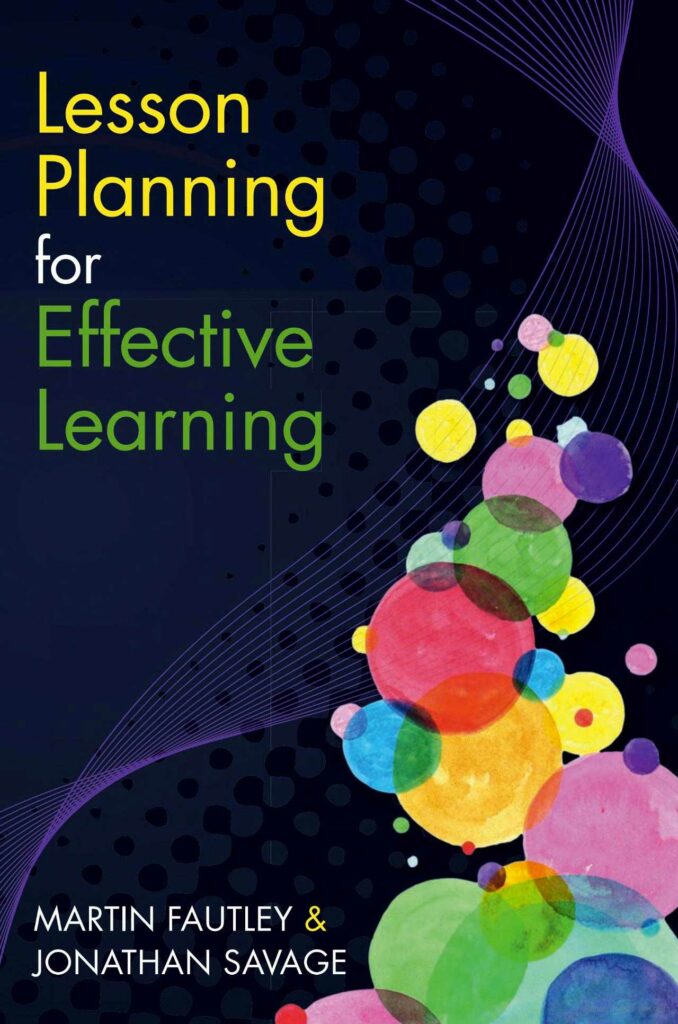
Content
1 Common components of a lesson
2 Lesson planning itself
3 Pedagogy and the plan: bringing it to life
4 Resources for learning
5 Differentiation and personalization: valuing your pupils
6 Metaphors for lesson planning and pedagogy
7 Learning
8 Assessment and lesson planning
9 Lesson, medium- and long-term planning
10 Differences in planning in the primary and secondary school
11 Lesson planning documentation
More Planning Templates
content and language objectives planning template
for kindergarten
Math
5E Lesson Plan
5E Template

Let me help you make template, for free!
Hi teachers! One of my hobbies is creating templates in Microsoft Word, Google Docs, Microsoft Power Points, and Google Slides. If you found a template in pdf and you want to make it available in editable formats, such as in: Word, Google Docs, Slides, Powerpoint, let me help you make one. It’s free! I love to do that for you. Just contact me.
Aliv Faizal M
I am a teacher who loves to use technology. I like to design templates in Google Docs, Google Slides, Powerpoint, Word, CorelDraw, etc.
